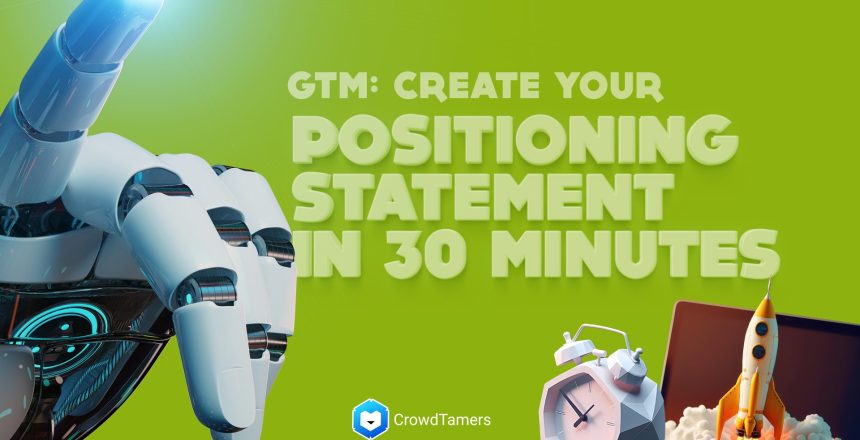I’ve created a tool to let you write your first positioning statement & your first landing page in 30 minutes, even if you’re a complete newbie at marketing.
One of the cool things I’ve been learning with prompt engineering recently is that you can condense decades of experience into something that someone can press a button and do, if you write the correct prompt.
Let’s show what I mean:
Now, the writing quality for GPT4 remains mediocre, but as even a blind pig finds a truffle every now and then, you can use this board from Xray.tech to start:
https://app.xrayworkflow.com/b/e537c233-3a7c-40b1-975d-b63aeca1d73f
Here’s what we’re doing:
- Use the first prompt I engineered to create 9 different positioning statements. As you can see from the video above, there’s a fair likelihood that you’ll need to refine your persona or your product description a few times before you get output that really speaks to the unique power of your product.
- This prompt is engineered to produce output basically similar to our blog post about how to create high-quality headlines in just a few minutes.
- Use that output + the second prompt to create the text outline for a landing page that speaks to those features.
- This prompt is engineered to give you content similar to what you’d get if you followed our guide on how to write a high-conversion landing page.
ChatGPT offers powerful prompts that can assist in developing your positioning statement. These prompts can be customized to suit your product and target audience.
Combined with additional details about the automation tools used, this prompt provides a solid foundation for crafting a clear and concise positioning statement.
Communicate value with a good landing page
A well-crafted landing page is essential for effectively communicating your product’s value proposition. Using ChatGPT prompts, you can streamline the process of writing landing page text. The above prompt is gonna generate the following for you:
- Hero headline: Create a headline that captures attention and conveys the primary benefit.
- Subheadline: Reinforce the key message in a concise and compelling manner.
- User quotes: Incorporate testimonials or social proof to build credibility.
- Benefit statement: Clearly articulate the benefits users can expect from the product.
- How it works: Describe the process or features of the product to provide clarity.
- Who it’s for: Identify the target audience for the product.
- Call to action: Encourage users to take the desired action.
- Additional benefits: Highlight any other benefits or unique features.
- Call to action (repeated): Reinforce the primary call to action for the user.
Laying out & designing your landing page
Once that’s finished, you can get started laying out & designing your landing page:
One of Figma’s standout features is the Figma Community, which provides access to a wide range of design resources. By searching for landing page templates within the Figma Community, you can find inspiration and ready-to-use designs for your own landing page. Here’s the basics of the video above:
- To streamline the design process, consider using a UI kit like Landify from the Figma Community. UI kits are pre-designed collections of components that you can use to build your landing page. Landify, for example, offers a variety of sections such as headers, hero sections, testimonials, and more. Customize these pre-designed blocks to match your brand’s colors and graphics.
- Once you have selected a UI kit or template, it’s time to start building your landing page. Create a new frame in Figma and set the dimensions to match a standard width, such as 1440 pixels, and an appropriate height. Name the frame to identify your landing page project.
- Begin by adding the essential sections to your landing page, such as the navbar and hero section. You can easily copy and paste the desired sections from the UI kit into your frame. Customize the elements within each section, such as replacing placeholder images and adjusting text to match your content.
- Once you have the basic layout, replace the template’s images with ones that suit your content. Use free resources like Unsplash or illustration libraries to find suitable visuals that resonate with your target audience. Update the background color, typography, and other design elements to match your brand’s style.
- Strategically position your CTAs so they are visually distinct, guiding visitors to take the desired action. Consider using contrasting colors and attention-grabbing designs to make your CTAs stand out.
Stumped on ideas? Use ChatGPT!
Stuck for ideas on how to get your new idea to market? Get un-stuck with ChatGPT!
Review the overall layout and flow of your landing page. Make adjustments as needed to ensure a seamless user experience and improve readability. You can trim down any excessive text and refine the design until you are satisfied with the final result.
Pay attention to color schemes, typography, and consistency across sections to maintain a cohesive visual identity. Consider adding additional sections like testimonials, features, and pricing to enhance the effectiveness of your landing page.



